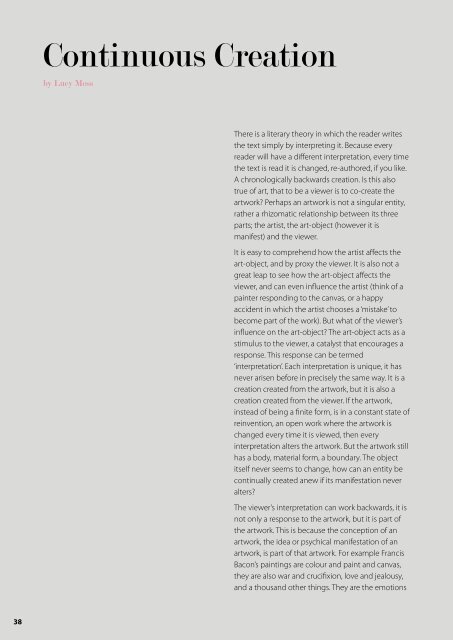_1215_fine_art_catalogue
Create successful ePaper yourself
Turn your PDF publications into a flip-book with our unique Google optimized e-Paper software.
Continuous Creation<br />
by Lucy Moss<br />
There is a literary theory in which the reader writes<br />
the text simply by interpreting it. Because every<br />
reader will have a different interpretation, every time<br />
the text is read it is changed, re-authored, if you like.<br />
A chronologically backwards creation. Is this also<br />
true of <strong>art</strong>, that to be a viewer is to co-create the<br />
<strong>art</strong>work? Perhaps an <strong>art</strong>work is not a singular entity,<br />
rather a rhizomatic relationship between its three<br />
p<strong>art</strong>s; the <strong>art</strong>ist, the <strong>art</strong>-object (however it is<br />
manifest) and the viewer.<br />
It is easy to comprehend how the <strong>art</strong>ist affects the<br />
<strong>art</strong>-object, and by proxy the viewer. It is also not a<br />
great leap to see how the <strong>art</strong>-object affects the<br />
viewer, and can even influence the <strong>art</strong>ist (think of a<br />
painter responding to the canvas, or a happy<br />
accident in which the <strong>art</strong>ist chooses a ‘mistake’ to<br />
become p<strong>art</strong> of the work). But what of the viewer’s<br />
influence on the <strong>art</strong>-object? The <strong>art</strong>-object acts as a<br />
stimulus to the viewer, a catalyst that encourages a<br />
response. This response can be termed<br />
‘interpretation’. Each interpretation is unique, it has<br />
never arisen before in precisely the same way. It is a<br />
creation created from the <strong>art</strong>work, but it is also a<br />
creation created from the viewer. If the <strong>art</strong>work,<br />
instead of being a finite form, is in a constant state of<br />
reinvention, an open work where the <strong>art</strong>work is<br />
changed every time it is viewed, then every<br />
interpretation alters the <strong>art</strong>work. But the <strong>art</strong>work still<br />
has a body, material form, a boundary. The object<br />
itself never seems to change, how can an entity be<br />
continually created anew if its manifestation never<br />
alters?<br />
The viewer’s interpretation can work backwards, it is<br />
not only a response to the <strong>art</strong>work, but it is p<strong>art</strong> of<br />
the <strong>art</strong>work. This is because the conception of an<br />
<strong>art</strong>work, the idea or psychical manifestation of an<br />
<strong>art</strong>work, is p<strong>art</strong> of that <strong>art</strong>work. For example Francis<br />
Bacon’s paintings are colour and paint and canvas,<br />
they are also war and crucifixion, love and jealousy,<br />
and a thousand other things. They are the emotions<br />
they inspire and the resemblances of themselves<br />
that people hold in their heads. Because these<br />
things are p<strong>art</strong> of the <strong>art</strong>work, a viewer, simply by<br />
interpreting the <strong>art</strong>work shapes what that <strong>art</strong>work is,<br />
making it different whilst it physically remains the<br />
same. The viewer, by interpreting the <strong>art</strong>work,<br />
becomes, in p<strong>art</strong>, an author of that work. We return<br />
to the three p<strong>art</strong>s of the <strong>art</strong>work, the <strong>art</strong>ist, the<br />
<strong>art</strong>-object, and the viewer. Each can change if the<br />
others hold steady. The material the <strong>art</strong>work is made<br />
of can change, for example, yet if the idea of the<br />
<strong>art</strong>work remains intact, so does the <strong>art</strong>work. These<br />
‘mechanical’ rules seem to hold in other areas as<br />
well. Think of an object, a tin-opener. A tin opener is<br />
the metal that forms it. It is the shape, but it is also<br />
the idea of the tin opener, and the uses it is put to. It<br />
is its name and its name is a concept. The concept<br />
originates from us, therefore we make the tin opener<br />
what it is. What about other areas of <strong>art</strong>?<br />
Mechanically, an <strong>art</strong>work is akin to a song. A song is<br />
finished once it is written, or perhaps it was sung<br />
once. It is now complete, and doesn’t need to be<br />
sung again to be finished. But, if it was sung again,<br />
wouldn’t that second singing also be p<strong>art</strong> of that<br />
song? An <strong>art</strong>work, when complete, is a finite form,<br />
however it can be reinterpreted in infinite ways.<br />
Each of these is p<strong>art</strong> of the <strong>art</strong>work, yet none have to<br />
happen for the <strong>art</strong>work to be complete.<br />
So an <strong>art</strong>work ceases to be an object, it becomes a<br />
rhizomatic relationship of connections, momentary<br />
couplings, and un-couplings. An <strong>art</strong>-machine. Its<br />
cogs and gears, interpretations and influences. It is<br />
the reviews that are written about it, the contexts<br />
that surround it. While the <strong>art</strong>work has a finite body<br />
it contains infinite possibilities. It is paradoxically the<br />
infinite contained within the finite; a multiplicity,<br />
more than the sum of its p<strong>art</strong>s, a product of<br />
continuous creation.<br />
Where does this leave us as <strong>art</strong>ists, where does our<br />
authorship stand? If we view this rhizomatic<br />
relationship between <strong>art</strong>ist, <strong>art</strong>work and audience as<br />
a dialogue, this becomes a question of who is<br />
speaking, and who is speaking first? Just as it is<br />
important that the viewer reacts to the <strong>art</strong>work, it is<br />
also important that they have something to react to.<br />
As <strong>art</strong>ists we are instigators of the conversation,<br />
propagating a dialogue, giving it flesh, bones, a<br />
he<strong>art</strong>, and a ribcage. We bring it into existence, an<br />
active catalyst for the dialogue or ‘performance’ of<br />
the work to come. An <strong>art</strong>work is this movement<br />
between entities, a dialogue. But it is also an object,<br />
even if that object is an idea, made by the <strong>art</strong>ist, and<br />
it has many qualities other than communication.<br />
Artists travel the borders between what a thing is<br />
and what it is not. They are like a Shaman, a<br />
channeller, bringing a multiplicity of ideas,<br />
methodologies, theories and influences into the<br />
single pinpoint that is the <strong>art</strong>work.<br />
Continuous Creation<br />
38<br />
39





